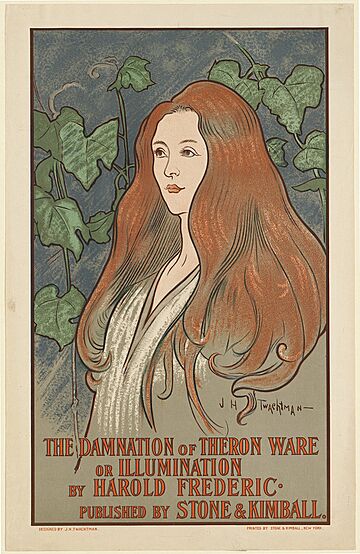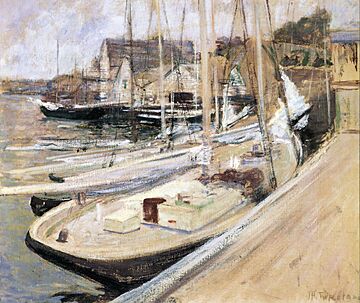John Henry Twachtman facts for kids
Quick facts for kids
John Henry Twachtman
|
|
|---|---|
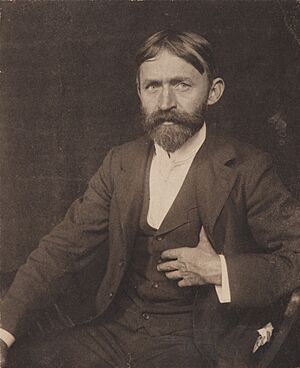
Twachtman, c. 1900. Photo by Gertrude Käsebier
|
|
| Born | August 4, 1853 Cincinnati, Ohio, US
|
| Died | August 8, 1902 (aged 49) |
| Education | Frank Duveneck; Royal Academy, Munich; Académie Julian, Paris |
| Known for | Impressionism, Landscape art |
John Henry Twachtman (born August 4, 1853 – died August 8, 1902) was an American painter. He is famous for his beautiful landscape paintings. His style changed a lot during his life. Experts say his American Impressionism style was very unique and experimental for his time. He was also part of a group called "The Ten." These ten American artists felt that the big art organizations weren't working well. So, in 1898, they decided to show their art together as a team.
Learning to Paint: Twachtman's Early Studies
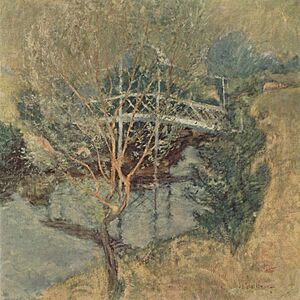
John Twachtman was born in Cincinnati, Ohio. He started learning art there. One of his first teachers was Frank Duveneck. Like many talented artists of his time, he went to Europe to study art.
In 1875, he joined the Academy of Fine Arts in Munich, Germany. He also visited Venice with Duveneck and William Merritt Chase in 1878. His paintings from this time show a loose, shadowy style. This was a common way of painting taught in Munich. Twachtman also learned etching. He sometimes carried etching plates with him to quickly draw a scene.
After a short trip back to America, Twachtman studied in Paris, France. He was at the Académie Julian from 1883 to 1885. During this time, his paintings changed a lot. They became soft, with many gray and green colors. This style is called tonalist. Some art experts believe he painted his best works during this period. These include Arques-la-Bataille and Springtime.
Becoming a Master: Twachtman's Later Years
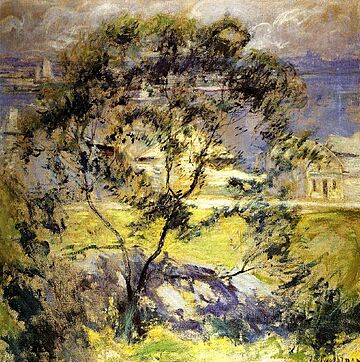
In 1886, Twachtman returned to America. In 1890, he bought a farm in Greenwich. He often painted with his friend, artist Julian Alden Weir. He also spent a lot of time at the Cos Cob art colony. This was a place where artists gathered to work and share ideas.
Art historian Susan G. Larkin said that Twachtman was very important to the Cos Cob colony. His personality helped keep the colony fresh and exciting. Even though he didn't sell many paintings, it allowed him to be truly creative. His art, talks, and teaching inspired his friends and students.
Besides oil paintings, Twachtman also made drawings using pastels. He taught painting at the Art Students League from 1889 until he passed away in 1902.
In Connecticut, his painting style changed again. It became a very personal form of impressionism. Twachtman painted many landscapes of his farm and garden in Greenwich. He often showed the snowy winter scenes. He even painted a small waterfall on his property dozens of times. He captured it in different seasons and at different times of day.
In the summers of 1900 to 1902, Twachtman visited Gloucester, Massachusetts. This was another popular place for artists. There, he created a series of bright, lively scenes. These paintings hinted at a more modern art style that would become popular later.
Twachtman died suddenly in Gloucester. He was 49 years old. Today, his artworks are in many famous museums. These include the Metropolitan Museum of Art in New York and the National Gallery of Art in Washington, D.C.
See also
- Art Students League
- Ten American Painters
- Society of American Artists


